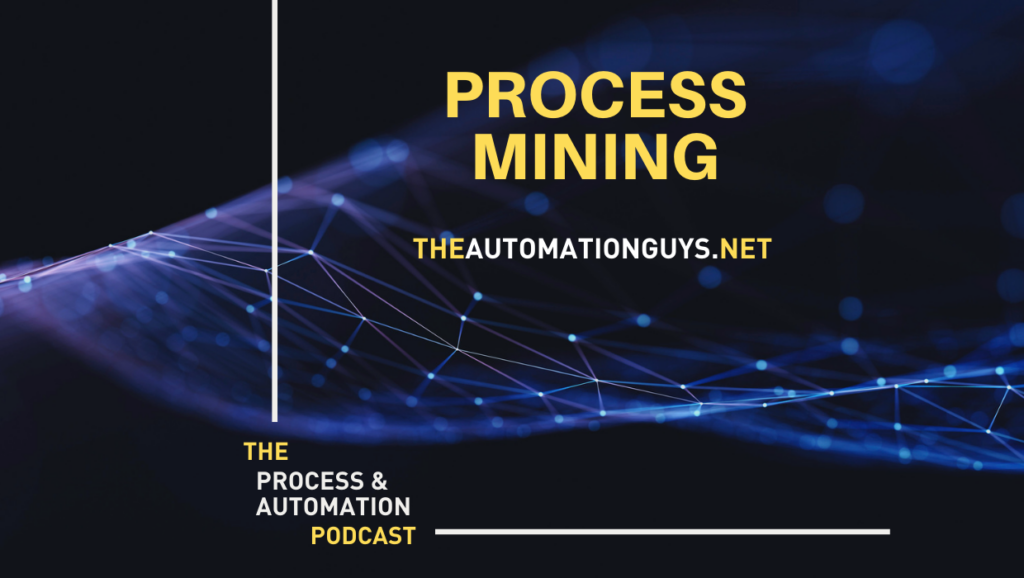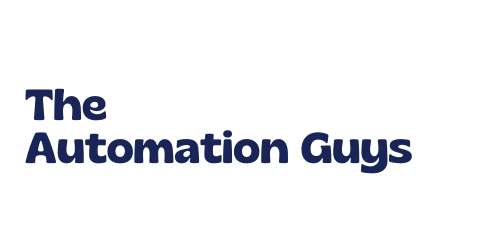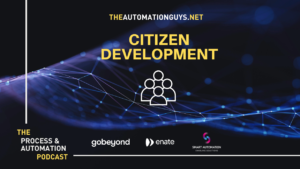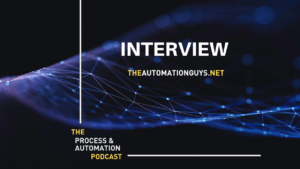Blog

In Part 2 of this episode you’ll find more answers to the most common questions that we get from companies, mainly asking if they could use process mining to gain insights into their operations and business processes.
Share This Post
Do you have any questions? Would you like to give us feedback? Are you interested in workshops on the topic of automation? Are you an expert in the field of automation and would like to be on the podcast?
LinkedIn Arno: https://bit.ly/3aABArd
LinkedIn Sascha: https://bit.ly/36Jd31T
Velocity-IT: https://www.velocity-it.com/about-us/
convedo Group: https://www.convedo.com/about-us
Episode Transcript
On the order or on the customer record so we can, um, So take, take this even further. So when problems occur, we can take immediate action without necessarily the human in the loop and, um, can, can avoid even more, um, uh, problems, uh, or can, can react to these problems even quicker. So, yeah. Perfect to combine it.
Yeah, yeah.
Yeah. So the next one we received here on our list is, um, what kind of problems and solutions can we discover with process mining? And, um, yeah, so, so we covered that, I guess, in our previous podcast, a bit, um, a use case for process mining. Um, so which one do you think is, is a good one to start with Anil? I mean, there’s so many examples, but, um, it could be, um, if you look at, let’s say business development, that’s a good one.
I think business development is, is, um, is quite an important. Discipline with inside your business to get right. And perhaps, you know, there’s, there’s this areas with, uh, uh, with inside your business development, um, or even with your accounts payable where, you know, you’re having problems with a specific supplier or, um, problems with a specific, uh, account manager, for example.
Um, so process mining allows you to pinpoint who is causing these problems and also how big. These are in terms of business impact, um, you know, the, the, these, these, these types of problems and, um, you know, you, you could use these, um, you know, th th these tools built into, um, the process mining tools, um, you know, to, to, to be able to, um, you know, look at service level agreements, make sure that, that those are.
At year two, and you’ll also be able to spot the supplier or, or this account manager that that’s causing, you know, your organization sort of significant problems, um, or there’s errors, or perhaps there’s potential fraud with inside that realm. That’s really good. Um, uh, early warning system, um, you know, for your business, you also might find that, um, you know, employees in a specific geographic areas have not really understood how the ERP system works properly and you know, that might cause a lot of problems for you, which.
Which, you know, adds up to a very large business impact and, you know, that might then identify the need for more training for those employees within that business area or unit. And, um, you know, how to use that ERP system. And of course, you know, that that would result in significant cost savings to your business.
But if you didn’t have process mining, how could you identify that, that training? Is is needed, you know, for, for that specific, um, location, you know what I mean? Unless you actually are either just stumbled incidentally across it, or it’s sort of. Got caught by your training program, you know, so it can be very tailored and very precise.
Yeah, absolutely. And then can really uncover as well even. Um, you know, if someone is, uh, he is not familiar with the system and then the potential delay, uh, it has for certain process steps. So, and then, uh, yeah, can really come up with all sorts of information, um, to, to, to measure the impact. Um, yeah. And another, another problem when, um, uh, employees not necessarily follow, follow the, the, the main process.
So usually we all have this ideal process in mind. Um, and lots of department heads, they are sitting down and designing all this perfect process in Vizio and then doing the. The introduction to this process to, to, to the department. But there are so many, so many variations sometimes, uh, and, um, Yeah, because everyone is sort of living their process slightly different, sometimes living in different.
So yeah, this, this is a very important, um, um, to, to really find out where all these variations of processes are. So, um, these variations are causing issues. Um, uh, generally, so, so. But what’s process and you can, then I uncover these variations and say, okay, how can we tame it? Uh, and then if you’re thinking about robotic process automation, um, um, so we could then see, okay, well, how could we potentially get the process?
Uh, again, sort of more, more unified, again, more streamlined again? Why? Uh, maybe just passing it onto a bot because people are getting maybe confused anyway. They don’t like the process, maybe. So if we pass it on to a bot. The bot can concentrate on it will process everything. Um, but yeah, so all those kinds of variations, um, and, uh, and potential for robotic process automation, we can also uncover, um, was, uh, was process mining.
Um, yeah, we, we, we could potentially even record lots of different, uh, sessions of users and to identify how are people working in within the process and by understanding all that stuff. We can then come up with really, really good rules when to use a bot and fill our pipeline as well for our RPA projects.
Yeah, that’s true. And I think, you know, RPA in itself, um, you know, it can be actually quite costly to implement if you don’t really have a sufficient understanding of your processes. So, you know, um, Process mining shows those variations, like you said, and also shows you, you know, what’s the common ones and the common ones are usually the ones that that’s really good for, for RPI.
So this is really, really good tool, a really good way to, to, um, You know, to improve your processes, standardize it, and kind of identify those common ones that, that you can actually push, um, you know, uh, through, through, um, your RPA bots, for example, uh, rather than doing it manually. And you know, if you still have to do it manually, I think that’s fine.
Um, You know, you, you can use process mining tools to, to identify these processes. You can then from, let’s say, operationally, understand how you need to change them. And then you can measure if people actually adopted the changes. This is one thing telling people, you know, this is the changes we need. Um, but how do you measure that?
How do you know that people actually are living these processes? Like you say, the way they should. Um, and process mining do give you that, uh, I call it telemetry. It’s almost like a business telemetry, that real runtime telemetry that you could measure and say, you know, we have adapted our training programs, um, and we are seeing the data is showing us that people are actually, um, you know, doing the processes the way they should be enhanced while we see the bottlenecks reducing and.
The, you know, the, the problems, um, in these processes going away. Yeah. And then, and we can really identify as well. Yeah. All these, um, all processes are running maybe in different regions. Um, our process. Yeah. We can really identify as well, all the touchpoints, um, off, um, Uh, in our processes who who’s doing, what, and then really identify lots of these opportunities as you said.
So the common ones, and then this can save millions, really if, uh, if we do it in the larger scale and then the right organization, um, we can reduce sort of data touch points, um, uh, in, in the processes, by, you know, by, by first identity, find these variations and then put automations in. So, so it runs much, much, much smoother.
Yeah, good. So another one we received is a common one where, um, and this is, this is sort of reflects the reality where people say, well, our data are in different systems. Can we still use process mining software to connect these systems and combine the data from, from different sources to gain these insights?
And the answer to that. Is it categoric? Yes. Because process mining software, do you have connectors that enable you to transfer data between, um, you know, the various systems to unlock this data and enable the software to connect to these varieties of. Single source of truth system. So, so these connectors then allows your process, mining analyzer, um, you know, to, to, to look at, you know, data across your enterprise.
Um, so it enables you to, to really look at data quality and also deploy real-time analysis across your bank to say so, you know, so if you do have disconnected data systems and applications, um, so you might have. You know, several SAP instances, which we see a lot, uh, you might have Salesforce, um, you know, you might have custom SQL databases, Excel files, um, so using process mining software and the connectors they provide, you can bring all of that event data from all of these, these platforms and bring that into your, your mining model.
And that’s really, really useful. Um, you know, for, for you to see that, that, that sort of, that bigger picture. Um, so it’s not just kind of targeting one specific silo. Yeah, and I think it’s, uh, I think this is the key, actually. It’s not, not that we can generally support, um, was process mining, looking into other systems.
I believe this is fundamentally important to do that actually, because how would you otherwise really determine, um, your end to end process? How it really. Right. It runs. So if you only have the chance to look at the individual system, that’s great that you know, everything, what you’re doing in Salesforce is, is not working or where it’s not working.
Um, I think because we have so many different systems these days, um, I think when, when we’re very modern on the companies, they. To, to have this 20, 30, 40 different cloud applications, um, and where they sort of have one process end to end through these 20 applications. Um, and never, they wouldn’t be of process mining.
Wouldn’t be able to gather all that information from all those systems would just give you really not a true picture. Uh, and, and would you wouldn’t really see. Where, where things are going wrong. So it’s, it’s fundamental that process mining tools can have as many connectors as possible. So this is, this is key.
So, um, and, um, yeah, it was that you have to chance, um, to really identify everything. And it goes really that far. So, so I mentioned just the recording earlier on. So, so there’s process mining, but part of the process, there are lots of tasks. So when task mining process mining are now. Sort of terms, um, where we often use together.
So, um, So you really have to identify as well, not just was this happening in the, in the, in the silo systems really what’s happening also on the desktop of the, of the user. Um, what kind of tasks is this user doing? Uh, on a day to day? Um, maybe it is purely XL. They are working on half of the process and then it moves into another system or a few other systems, but that activity, what happens in Excel.
Uh, we also want to know about, uh, ideally, um, to get a full picture. Absolutely. Good. So, um, and the next one is, um, a typical one. So we, we obviously talk about this topic a lot and then customer, I think. Yeah, that’s great. Um, so, um, so what, what is required from, uh, from, from, from, from a business in order to use, um, process mining?
Um, so, so w what, what would it, what would be needed. Well, of course, um, you know, an easy place to start is if you have a centralized ERP system or a single source of truth system, um, you can, of course combined things using connectors and, and most process mining tools obviously support that, um, that aggregation of data.
But I think, you know, from, from a very practical perspective that this really sort of just three steps to. Um, you know, to, to exploit process mining, um, and, and, and really, you know, the first one is as connecting your data to a model. Um, and you know, this is where you take your process mining tool. Um, you, um, connected to a data source or data sources, um, eat then brings that data, um, into your model.
Um, and that’s then ready for. Analysis. So, so it’s really kind of just sucking that into that model process, mining tool and understanding the, the makeup of that data. And then your, your, your ready for your analysis. That analysis part is, is really, I guess, that you know, where, where, where the magic happens, so to speak where whereby your.
Process analysis, um, cycle starts on, on your data. Um, and you know, this, this could be a longer, uh, sort of activity. Um, and, and this is where, um, you know, your, uh, process mining analyzer, which would really present you with, um, you know, various things in your data. That’s that that is of interest. So, so that’s sort of taking that business telemetry, um, and bringing it into life to give you insight.
So once the data is into the model, the model then turns into insight. That’s where you actually see the telemetry come to life. And then the third thing is it’s really, um, You know, the oldest third part of the journey, it’s really where you, um, you start making changes to your process based on the insights you’ve gained from, from the previous step.
Um, and that’s where you unlock the value of process mining. Um, so there might be a particular process that you focused on. Um, you might’ve, um, gained an insight that it, there is a bottleneck. Because of a problem. Um, you might end the site to actually change the process and deploy RPA software. And then again, if you look at your insights for your, um, uh, sort of, uh, the new data that that did, or the new telemetry that comes through, um, You, you will see that problem go away because the bottleneck is reduced.
So, so it’s, it’s, it’s really quite simple. Um, you know, these, these, these sort of three steps steps, again, kind of get the data source, put it in the model, extract the insights, uh, you know, um, tweak the process and, and really see, see the changes and, and extract the value from that. Absolutely. Yeah. I think that brings us, um, you know, it brings us to an end of our episode.
Um, and, uh, yeah, I think, um, yeah, it’s, it’s a really good time to take a look at your processes, process mining. Um, so there are lots of easy, easy ways into it. So proof of value will be really good start. Yeah. Reach out to, to Arno myself, um, by the, the automation guys.net website to, to just, um, get the.
Started, um, if you, if you want further information on it, we will have, uh, more, more, um, uh, episodes coming up on process mining. Um, yeah, it’s good to also to look back at our previous process, mining, uh, episodes and intelligent automation episodes. So, so you can see how we bring all these things together.
For maximum value and, um, yeah, so that’s, uh, that’s it for today. Thank you very much for, for listening. And hopefully this episode was useful for you and we’ll get you get your start. It was process mining and, um, you know, it’s always, um, yeah. Thank you.
Unfortunately that’s it again with this episode of the process in automation podcast. If you liked this episode, please give us a five-star rating and don’t forget to subscribe to this podcast. So you don’t miss any upcoming episode tune in next time. And until then, Let’s automate it.
- April 19, 2021
- 8:33 pm


